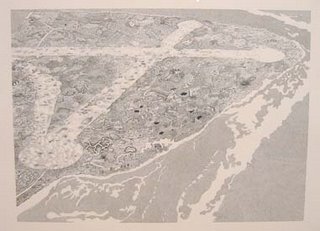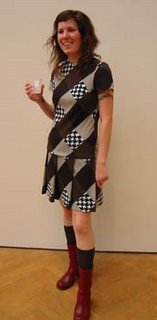 I previewed the Mills College MFA show and can recommend it to Bay Area art lovers. It’s a small show—there are only 12 graduates—but it’s rewarding. There will be a public reception on Sunday, April 30th, from 2:00 to 4:00 pm. The show, located in the Mills Art Museum, runs through May 28th.
I previewed the Mills College MFA show and can recommend it to Bay Area art lovers. It’s a small show—there are only 12 graduates—but it’s rewarding. There will be a public reception on Sunday, April 30th, from 2:00 to 4:00 pm. The show, located in the Mills Art Museum, runs through May 28th.I was much taken with the ink drawings by Nadol Pak. Of compact size, they bear a family resemblance to work by New York artists Jacob El Hanani and Daniel Zeller. But Pak is distinctive. He creates abstracted landscapes and cityscapes from a welter of small marks. The marks are highly inventive and reflect a background in cartooning. The drawings teem with them, although some drawings incorporate blank areas or quieter passages as breathing room. Space is flattened in a way that suggests Asian landscape painting. The density and size of the marks creates an internal scale that seems large. From a distance, though, the details of each drawing disappear and the work appears minimalist. This fusion of traditions with impish mark-making proves a winning combination. And the artist had the good sense to present his work in proper frames. I’m sure he’ll be taken up by a gallery shortly after he graduates, if not before. My camera is inadequate to capture work of such detail, but I have included one shot above, with apologies.
 Another artist who evokes delight using a small scale is Misako Inaoka. She has covered an extensive wall area with creatures whose DNA seem to have been scrambled against the rules. A red bird has a head of red berries. Two white birds are covered in growths that suggest camouflage among sea creatures. A yellow bird seems to grow from a knarly white root. These bird pieces are engaging, but they are uncomfortably close to the work of Los Angeles artist Carlee Fernandez. More distinctive were the many tiny creatures where the combinations seems less literal (detail above). Fellow artist Nadol Pak thought these look like toy prizes. They also might be menu items from a futuristic sushi bar.
Another artist who evokes delight using a small scale is Misako Inaoka. She has covered an extensive wall area with creatures whose DNA seem to have been scrambled against the rules. A red bird has a head of red berries. Two white birds are covered in growths that suggest camouflage among sea creatures. A yellow bird seems to grow from a knarly white root. These bird pieces are engaging, but they are uncomfortably close to the work of Los Angeles artist Carlee Fernandez. More distinctive were the many tiny creatures where the combinations seems less literal (detail above). Fellow artist Nadol Pak thought these look like toy prizes. They also might be menu items from a futuristic sushi bar. Diana Guerrero created a memorial to her father, who worked in a flower nursery in well-heeled Marin County where the workers’ only protection against pesticide sprays was paper masks. He died of stomach cancer in his early forties. Her installation combines family photographs with material from the now defunct nursery. In one section, an unnervingly sad photo of her father is hung above four decaying molds of a type of respirator that would have better protected him (photo above).
Diana Guerrero created a memorial to her father, who worked in a flower nursery in well-heeled Marin County where the workers’ only protection against pesticide sprays was paper masks. He died of stomach cancer in his early forties. Her installation combines family photographs with material from the now defunct nursery. In one section, an unnervingly sad photo of her father is hung above four decaying molds of a type of respirator that would have better protected him (photo above). Krishna Khalsa used hundreds of small pieces of wood to build a remarkable passage between the first and second rooms of the exhibition (detail above). She then added another outgrowth of this material in a corner, peeking over a wall. The effect was a delightful transformation of humble materials, and of space. Krishna also showed up for the preview in a terrific dress, purchased for $8 in a thrift shop (photo below).
Krishna Khalsa used hundreds of small pieces of wood to build a remarkable passage between the first and second rooms of the exhibition (detail above). She then added another outgrowth of this material in a corner, peeking over a wall. The effect was a delightful transformation of humble materials, and of space. Krishna also showed up for the preview in a terrific dress, purchased for $8 in a thrift shop (photo below). Amy Rueffert's presentation consists of shiny sculptures that are meticulously hand-made despite a factory look. They reference Modernist sculpture (and perhaps the ceramics industry) while trafficking in sexy bulges (detail below).
Amy Rueffert's presentation consists of shiny sculptures that are meticulously hand-made despite a factory look. They reference Modernist sculpture (and perhaps the ceramics industry) while trafficking in sexy bulges (detail below). A couple of other presentations are also of interest. Directions for getting to Mills via the freeway are posted on the college website.
A couple of other presentations are also of interest. Directions for getting to Mills via the freeway are posted on the college website.

No comments:
Post a Comment